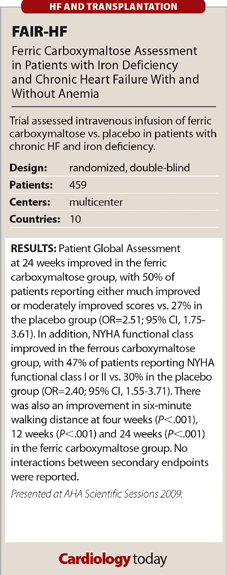FAIR-HF: Intravenous infusion of ferric carboxymaltose linked with improved health status
Both patient self-assessment and physician assessment using NYHA functional class improved.
American Heart Association Scientific Sessions 2009
The intravenous infusion of ferric carboxymaltose in patients with chronic HF and iron deficiency led to improved health status and NYHA functional class, study results suggested.
Researchers for the FAIR-HF study enrolled 459 patients (52% women) with chronic HF and iron deficiency (with or without anemia) in the study and randomly assigned them to receive intravenous ferric carboxymaltose (n=304) or placebo (n=155). The primary study endpoint was Patient Global Assessment (PGA) at 24 weeks and NYHA class assessment at 24 weeks.
The researchers reported that PGA at 24 weeks improved in the ferric carboxymaltose group, with 50% of patients reporting either much improved or moderately improved scores vs. 27% in the placebo group (OR=2.51; 95% CI, 1.75-3.61). In addition, NYHA functional class improved in the ferrous carboxymaltose group, with 47% of patients reporting NYHA functional class I or II vs. 30% in the placebo group (OR=2.40; 95% CI, 1.55-3.71). There was also an improvement in six-minute walking distance at four weeks (P<.001), 12 weeks (P<.001) and 24 weeks (P<.001) in the ferric carboxymaltose group. No interactions between secondary endpoints were reported.
“Giving 24 weeks of ferric carboxymaltose in patients with systolic HF who are symptomatic and have iron deficiency is beneficial for the patients regarding self-reported global health, NYHA functional class, six-minute walk distance and quality of life measurements,” Stephen D. Anker, MD, a cardiologist at the Campus Virchow-Klinikum of Charite Universitätsmedizin in Berlin, Germany, said in his presentation. “If a patient is symptomatic with HF and has iron deficiency, which is simple to assess, the treatment with intravenous iron should be considered.” – by Eric Raible
For more information:
- Anker S. LB04 #150. Presented at: American Heart Association Scientific Sessions 2009; Nov. 14-18; Orlando, Fla.

![]()
As we move forward, there are some clarifications to be considered. We should look at the rate of rise in hemoglobin and the safety associated with the use of intravenous iron. We should also look at the separation of iron between the two groups. There was a dramatic change in quality of life and exercise capacity at four weeks, suggesting that some of this benefit could be from the enrollment in the clinical trial and the excellent care that the patients received. It would be important to correlate the achieved hemoglobin and/or iron and patient-reported outcomes, as well as NYHA class and exercise capacity. I must also emphasize the quality of the blind, given that the placebo was saline, and there may be a potential impact on hospitalization or emergency room visit on maintenance of the double-blinded status and the outcomes because patients may be aware of their hemoglobin levels. We should also consider the tolerability of this preparation vs. other iron preparations, both oral and intravenous. Finally, we should look at the long-term safety and efficacy of this therapy in this patient population.
– Eldrin F. Lewis, MD
Cardiologist, Brigham and Women’s Hospital, Boston

